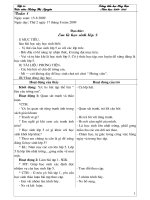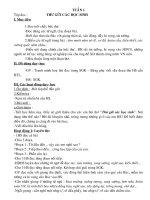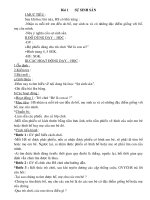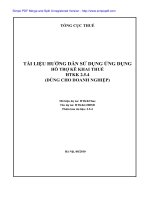- Trang chủ >>
- Mầm non - Tiểu học >>
- Lớp 5
5 4 1 cheaper, faster, better recent technological innovations (social studies) TG
Bạn đang xem bản rút gọn của tài liệu. Xem và tải ngay bản đầy đủ của tài liệu tại đây (138.32 KB, 4 trang )
Cheaper, Faster, Better
SUMMARY
Technological advances in the past
twenty years, such as the creation of the personal computer, the Internet, cell phones, and
DVD players, have had a huge impact on the
way we run our daily lives. The Computer Age
has affected everything from the way we shop
and write to the way we learn.
LESSON VOCABULARY
CD-ROM
computer viruses
Industrial Revolution
search engine
word processors
Computer Age
e-mail
Internet
telecommuting
World Wide Web
INTRODUCE THE BOOK
INTRODUCE THE TITLE AND AUTHOR
Discuss
with students the title and the author of
Cheaper, Faster, Better: Recent Technological
Innovations. Ask students to name some technological innovations that have made things
cheaper, better, or faster.
BUILD BACKGROUND
Ask students to discuss
the computerized devices they use every day.
Have students share stories about using the
World Wide Web to complete daily activities,
such as looking up weather reports or checking movie times.
PREVIEW/USE TEXT FEATURES Have students preview the text by looking at the Table of Contents,
the photos and captions, the heading/subheadings, and the time line. Ask students what they
expect to learn from the book.
READ THE BOOK
SET PURPOSE Have students set a purpose for
reading Cheaper, Faster, Better. Guide students
to an interest in what life was like before computers and encourage an interest in the many
inventions discussed in the text, including the
Internet and World Wide Web.
72
5.4.1
DRAW CONCLUSIONS
ANSWER QUESTIONS
Ask students to discuss what the word
revolution means to them. Share examples
of inventions created during the Industrial
Revolution. Ask: “How might an industrial revolution differ from a political revolution?”
STRATEGY SUPPORT: ANSWER QUESTIONS Note
for students that when they ask their own questions and practice QAR, they will be able to draw
better conclusions about a paragraph, chapter
or entire text. Have students practice this skill
after they have finished the text by working in
pairs. Have one student in each pair write questions for the first two types of QAR. Have the
other student write questions for the second two
types. Then have the students in a pair swap
questions and answer them.
COMPREHENSION QUESTIONS
PAGES 4-5
What problems did Sally confront?
(Research was tedious, overseas mail took a
long time, photos had to be processed at a lab,
typewriters made it hard to correct errors, etc.)
PAGE 8
What are the benefits of word processors? (Changing and formatting text is easy;
spell-checkers are helpful.)
PAGE 11
How are the Industrial Revolution and
Computer Age similar? (Both led to dramatic
changes and inventions to simplify tasks.)
PAGE 16
Why are search engines important for
students? (Research is simpler and less timeconsuming. Instant access to global information.)
PAGES 20–21
What conclusions can you draw
about the benefits and drawbacks of computer
technology? (Benefits: speedy access to information; tasks are easier to accomplish. Drawbacks:
computer viruses must be controlled; important
hands-on interaction is lost.)
Cheaper, Faster, Better
16924_LRD_TG_072-073 72
6/16/06 12:16:58 PM
REVISIT THE BOOK
READER RESPONSE
1. Advantages: can work from home, don’t
have to dress up for work, can set own
schedule. Disadvantages: don’t get to interact with colleagues, dependent on computer to get work done, could be lonely or
distracting. Telecommuting is likely to be
more popular.
2. Sample questions: “How did you come up
with the idea for the WWW? When? Why?
What is the future of the WWW?”
3. Sample: We lost our Internet connection when the power went out. Then, we
couldn’t surf the World Wide Web to find
movie show times.
4. Answers will vary. The computers shown
are different in size and appearance than
the computers of today.
EXTEND UNDERSTANDING Direct students to the
timeline on pages 18 and 19. Note that several
years – 1991, 1996, 1997, 1999, 2001, 2002,
2003 and 2005 – are not included. Have students research technological developments in
these years to supplement the timeline. Create
a class timeline with graphics (one year per
page) and paste the timeline around the room or
assemble it into a booklet.
RESPONSE OPTIONS
WRITING Have students write a short description of a problem for which they’d like to find a
high-tech solution. Then, have them describe the
solution. Encourage students to draw a picture
of their solution.
SOCIAL STUDIES
CONNECTION
Have students use the
Internet or library books to
research the history of the Internet or
the Industrial Revolution. Have students
present their findings to the class.
Skill Work
TEACH/REVIEW VOCABULARY
Have students share the meaning of glossary terms they know, then define words
they don’t. Make sure students understand
the difference between the Internet and
the World Wide Web. Ask if any students
have parents who telecommute; have them
describe this way of working.
TARGET SKILL AND STRATEGY
Remind students that
a conclusion is a sensible decision reached
after thinking about details or facts in what
you read. Drawing conclusions is the process of making those decisions. Encourage
students to draw conclusions after considering the facts given in a paragraph or
section of text. Encourage students to ask
themselves if their conclusions make sense
and to back up conclusions with information
from the text or other reasons. Conclusions
should be logical.
DRAW CONCLUSIONS
ANSWER QUESTIONS Review the QAR
(Question-Answer Relationship) strategy which
teaches students four types of questions:
Right There: The answer is in a sentence
in the text. Think and Search: The answer
is in several places in the text. Author and
You: The answer is not explicitly in the text;
students need text and prior knowledge to
find it. On My Own: The answer is not in the
text and students will need to do additional
research to find it.
ADDITIONAL SKILL INSTRUCTION
CAUSE AND EFFECT Remind students that a
cause is why something happened, while an
effect is what happened. Explain that sometimes there are no clue words, such as since,
thus, as a result, therefore, or consequently, to
help you figure out what happened and why.
Also, sometimes the cause is not directly stated, and you need to think about why something happened on your own.
Cheaper, Faster, Better
16924_LRD_TG_072-073 73
73
10/20/05 2:39:30 PM
Cheaper, Faster, Better
Name
Draw Conclusions
• A conclusion is a sensible decision you reach after you think about the details or the facts in
what you read.
• Drawing conclusions means to make sensible decisions or form reasonable opinions after
thinking about the details or facts in what you read.
Directions Read the paragraph below, then answer the questions that follow.
C
ompleting tasks we now do quickly
was not nearly as easy in the
1970s, when Sally was growing up. If
Sally wished to do research for a report,
she had to ask her parents to drive her
to the library. There, she used a large
encyclopedia; her parents could not afford
to buy her such a set. If Sally needed to
type her report, she had to use a manual
typewriter. Whenever she made mistakes,
she had to use a special white solution
to paint over the wrong letters. Then she
could retype the correct letters. When Sally
didn’t remember the spelling for a word,
she hauled out a huge dictionary to look it
up. Sally was also a movie buff. To figure
out which shows she would attend, she had
to wait for the newspaper to be delivered.
And if she wanted to shop, her only
choices were to go to a mall and endure
long lines and bustling crowds or to pore
over heavy catalogues. If she wanted to
shop at midnight, she was out of luck!
1. What conclusion can you draw about what it was like to do homework in the 1970s?
3. What conclusions can you draw about what shopping was like in the 1970s?
4. Give two facts or details to support your conclusion.
© Pearson Education 5
2. Give two facts or details to support your conclusion.
5. Write a well-supported conclusion about how technology would have made life easier for Sally.
74
16924_LRD_TG_074_075 1
10/20/05 2:39:54 PM
Cheaper, Faster, Better
Name
Vocabulary
Directions Choose the word from the box that best matches each
definition. Write the word on the line.
Check the Words
You Know
CD-ROM
Computer Age
computer viruses
Industrial Revolution
Internet
search engine
telecommuting
word processors
World Wide Web
1. when people work from home using their personal computers
2. programs, designed by people, that do damage to computers
or data
3. system that allows people to review, retrieve, and modify the
Web sites found on the Internet
4. a compact disc that plays on a computer’s CD-ROM drive
5. a term describing the changes in technology of the 1800s that
changed how people lived
6. a program that helps people find data on the Internet
© Pearson Education 5
7. system of sending messages using computers linked by
telephone wires
8. worldwide computer network, linked by telephone lines, that
is used to send messages, data, and other services
9. a term used to describe how computers have transformed
modern life
10. computer programs that edit, store, and retrieve documents
and texts
75
16924_LRD_TG_074_075 2
10/20/05 2:39:56 PM









